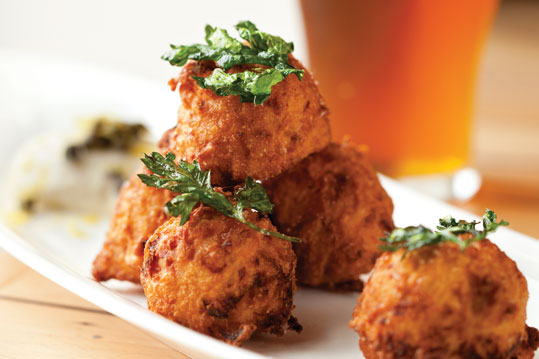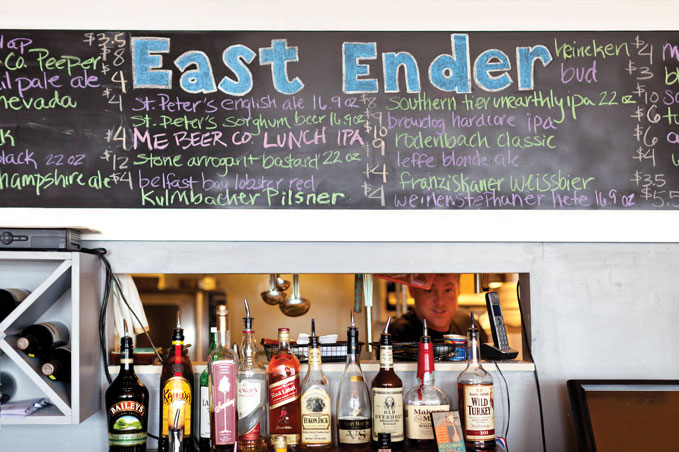East Ender
EAT-August 2011
By Joe Ricchio
Photographs by Kristen Teig
The philosophy at the East Ends newest restaurant and lounge is simple comfort food prepared the right way. Ill drink to that.
“I like to put lots of effort into simple food.”
This is chef Mitch Gerow’s philosophy, which comes to life when one tastes his trout fritters with caper sour cream.
When Gerow and his business partner, Megan Schroeter, opened the East Ender this past January, they envisioned a place that would evolve with the neighborhood. “We figured that the community would tell us what it was going to be,” says Schroeter, a Saco native. “Would it be more of a late-night bar scene or a steady dinner crowd? We knew we just had to wait and see.”
The menu is as diverse as the East End itself—its selections range from Peacock oysters on the half shell topped with finely minced carrot and champagne mignonette to crispy fried calf brains served with Saratoga chips and French onion dip. A small but focused wine selection complements more refined entrees such as seared scallops with soubise sauce and white asparagus—all prepared brilliantly. As the theme for a recent beer-oriented tasting menu, Gerow decided to pair several courses with “what we’ve already got on draught,” adding a fun twist that showcased the restaurant’s commitment to elegant simplicity.
Schroeter and Gerow met each other while working at a French restaurant in Portland, and the pieces began falling into place from there. Schroeter has been in “the business” since she was 13. After minoring in hospitality in college, a stint at the Four Seasons Hotel in Boston made her realize that the corporate world was not for her. She began waiting tables at an independently owned restaurant in Brookline, Massachusetts, and it soon became apparent that her next step would be management, as she worked toward the goal of owning her own business.
Gerow’s childhood in Saratoga Springs, New York, set the stage early on for a career in the kitchen. His father loved to hunt, fish, and work the garden, while his mother routinely spent the entire day cooking in the kitchen. “She was always making the kinds of meals that would need to be started on Thursday in order to eat them on Sunday. By the time I was seven, I was making my own lunch and cooking dinner for the family once or twice a week,” says Gerow. “I learned a lot about everything from gardening to canning and preserving. When I was 16, I started working in restaurants that my dad liked to eat at, starting as a dishwasher and working my way up to the line.” Gerow then spent several years working in various resort towns “cooking, skiing, and partying,” he says. “I’d say the best lessons taken from this period were what not to do in the restaurant business, which are almost more important than knowing the way you should do things.”
“When I began to get old in my mid-twenties,” he jokes, “I got very much into gaining recognition for myself, and I started experimenting with food trends.” He worked as sous chef for Bill Poirier at Sonsie in Boston, where he honed his skills in preparation for opening his own place, which he did in 1996 and aptly named the Good Life. Although successful, Gerow wasn’t completely sure that his first restaurant was “the one,” and he sold it a few years later. He returned to the line once again, eventually winding up as executive chef for Jean Joho at his downtown Boston bistro, Brasserie Jo.
Although Gerow enjoyed his tenure with Joho, a professional evolution was inevitable. After working as chef de cuisine at the Heights Cafe in Ithaca, New York, he was finally ready to flex his entrepreneurial muscles again. He moved to Portland with the intention of opening a restaurant focused on serving lunch—or at least that was what he intended at the time. When he and Schroeter crossed paths a couple of years later, they clicked and realized that, together, they could take a risk and make it work. While the East Ender space and location were exactly what they were looking for, there was a lot of work to be done. They installed a “back door” on the second level that didn’t previously exist, and they put down wood floors reclaimed from a bowling alley. Gradually, their vision came to life.
Since opening, the first floor has been converted into a casual lounge area, and the dining room and bar are on the second floor. The full dinner menu and bar menu, which features such enticements as lobster nachos, are available on both floors. Gerow has forged strong bonds with local purveyors, including Browne Trading Company, and continues to use them to supply his rollicking, ever-evolving menu.
The kitchen is open fairly late, which has turned the restaurant into a popular haunt for local restaurant workers in search of some after-work revitalization and conviviality. They can be found camping out at the bar, plowing through house cocktails like the Cucumber Collins, and enjoying mussels cooked in Genesee Cream Ale (hell yeah!) and served with chilies, deviled eggs, and fried chicken livers.
The East Ender continues to be molded by the neighborhood it calls home, but the style and philosophy of the food remains constant. There is a commitment to doing things the right way, even if that happens to be the hard way, because at the end of the day this is what makes it all worthwhile.



























